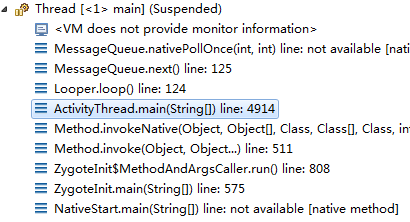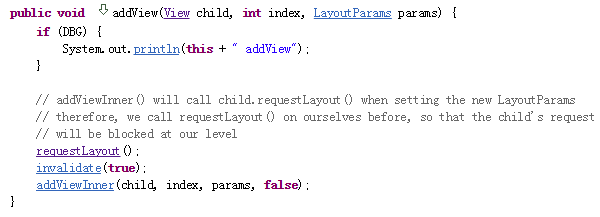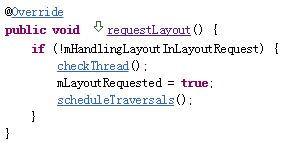首先追溯到Activity的启动,随便启动一个自己写的demo项目,使用DDMS进行debug标记,然后在Debug中把主线程暂停,可以看到调用栈。如下图所示:

于是我们先看android.app.ActivityThread的main()方法。
android.app.ActivityThread.main()
main()方法中对一个Looper对象进行初始化,形成一个消息循环,那么任何主线程的操作都会发送到这个Looper对应的Handler中去。通过源码,辗转反侧找到Handler的定义,它是ActivityThread中定义的一个内部类,名为H,继承自Handler。
观察它的handleMessage()方法,发现了其中有一个what值为LAUNCH_ACTIVITY的switch分支,其中调用了handleLaunchActivity()方法。

接下来看android.app.ActivityThread.handleLaunchActivity()方法。
android.app.ActivityThread.handleLaunchActivity()

如上图所示,该方法中执行了两个比较关键的步骤,一个是performLaunchActivity(),另一个是handleResumeActivity()。
先来看performLaunchActivity()做了什么。
android.app.ActivityThread.performLaunchActivity()
以下是部分源码,我做了一些省略。
1 private Activity performLaunchActivity(ActivityClientRecord r, Intent customIntent) { 2 3 ... 4 Activity activity = null; 5 try { 6 java.lang.ClassLoader cl = r.packageInfo.getClassLoader(); 7 activity = mInstrumentation.newActivity( 8 cl, component.getClassName(), r.intent); 9 StrictMode.incrementExpectedActivityCount(activity.getClass()); 10 r.intent.setExtrasClassLoader(cl); 11 if (r.state != null) { 12 r.state.setClassLoader(cl); 13 } 14 } catch (Exception e) { 15 if (!mInstrumentation.onException(activity, e)) { 16 throw new RuntimeException( 17 "Unable to instantiate activity " + component 18 + ": " + e.toString(), e); 19 } 20 } 21 22 try { 23 ... 24 if (activity != null) { 25 ... 26 27 activity.attach(appContext, this, getInstrumentation(), r.token, 28 r.ident, app, r.intent, r.activityInfo, title, r.parent, 29 r.embeddedID, r.lastNonConfigurationInstances, config); 30 ... 31 activity.mCalled = false; 32 mInstrumentation.callActivityOnCreate(activity, r.state); 33 ... 34 } 35 ... 36 } 37 ... 38 }
重点关注红色加粗的部分:
7, 8行:通过Activity的类名构建一个Activity对象。
27行:调用了Activity.attach()方法。
32行:通过Instrumentation对象执行Activity的onCreate()方法,Activity的生命周期方法都是由Instrumentation对象来调用的。
其中attach()方法里面也做了很重要的事情。
android.app.Activity.attach()
1 final void attach(Context context, ActivityThread aThread, 2 Instrumentation instr, IBinder token, int ident, 3 Application application, Intent intent, ActivityInfo info, 4 CharSequence title, Activity parent, String id, 5 NonConfigurationInstances lastNonConfigurationInstances, 6 Configuration config) { 7 attachBaseContext(context); 8 9 mFragments.attachActivity(this, mContainer, null); 10 11 mWindow = PolicyManager.makeNewWindow(this); 12 13 ... //将各种参数赋给Activity的成员变量 14 15 mWindow.setWindowManager( 16 (WindowManager)context.getSystemService(Context.WINDOW_SERVICE), 17 mToken, mComponent.flattenToString(), 18 (info.flags & ActivityInfo.FLAG_HARDWARE_ACCELERATED) != 0); 19 if (mParent != null) { 20 mWindow.setContainer(mParent.getWindow()); 21 } 22 mWindowManager = mWindow.getWindowManager(); 23 mCurrentConfig = config; 24 }
首先给Activity.mWindow成员变量赋值,然后给mWindow变量设置WindowManager,然后给Activity.mWindowManager赋值。
mWindow是一个Window类型的变量,但实际上它是一个PhoneWindow对象,与Activity的内容显示相关。
上面的attach()方法调用完成后,就自然而然的调用了Activity的onCreate()方法了。
按一般的情况,Activity中的onCreate()方法调用了setContentView()方法,而setContentView()方法并不是由Activity实现的,以下是android.app.Activity中的一段代码:
1 public void setContentView(View view, ViewGroup.LayoutParams params) { 2 getWindow().setContentView(view, params); 3 initActionBar(); 4 }
而getWindow()返回的是一个android.app.Window对象,这个对象就是刚刚在attach()中赋值的mWindow成员变量。
android.app.Window是一个抽象类,其中setContentView()方法并没有具体的实现,而这个方法的真正实现是com.android.internal.policy.impl.PhoneWindow类。使用类图表示:

以下是PhoneWindow中的setContentView()的代码。
1 @Override 2 public void setContentView(View view, ViewGroup.LayoutParams params) { 3 if (mContentParent == null) { 4 installDecor(); 5 } else { 6 mContentParent.removeAllViews(); 7 } 8 mContentParent.addView(view, params); 9 final Callback cb = getCallback(); 10 if (cb != null && !isDestroyed()) { 11 cb.onContentChanged(); 12 } 13 }
PhoneWindow类中有两个和视图相关的成员变量,一个是DecorView mDecor,另一个是ViewGroup mContentParent。
来看官方文档的描述:

再回到PhoneWindow.setContentView(View, ViewGroup.LayoutParams)中的installDecor()方法做了什么。
1 private void installDecor() { 2 if (mDecor == null) { 3 mDecor = generateDecor(); 4 ... 5 } 6 if (mContentParent == null) { 7 mContentParent = generateLayout(mDecor); 8 ... 9 } 10 }
mDecor是通过一个generateDecor()方法来获取的。而generateDecor()就是new了一个DecorView而已。
1 protected DecorView generateDecor() { 2 return new DecorView(getContext(), -1); 3 }
DecorView是PhoneWindow类中定义的一个内部类,它继承了FrameLayout,用来作为整个PhoneWindow的根视图。
再来看generateLayout()做了什么事情。
1 protected ViewGroup generateLayout(DecorView decor) { 2 3 //...以上省去,大致上是与样式,主题,版本相关的对视图的设置。 4 5 //以下开始填充decor 6 7 // Inflate the window decor. 8 int layoutResource; //这个是用来inflate的id 9 10 ... //这里省去,内容是根据Window的各种特性(feature)选择一个合适的视图id赋给layoutResource 11 12 mDecor.startChanging(); 13 14 View in = mLayoutInflater.inflate(layoutResource, null); 15 decor.addView(in, new ViewGroup.LayoutParams(MATCH_PARENT, MATCH_PARENT)); 16 17 ViewGroup contentParent = (ViewGroup)findViewById(ID_ANDROID_CONTENT); //注意这个地方 18 if (contentParent == null) { 19 throw new RuntimeException("Window couldn't find content container view"); 20 } 21 22 ... //省去,内容是设置背景,设置ActionBar的一些属性。 23 24 mDecor.finishChanging(); 25 26 return contentParent; 27 }
可以看出,这个方法(generateLayout())做了如下几件比较关键的事情:
1.根据各种FLAG值设置了LayoutParam参数,以上代码省略了这部分。
2.根据各种FEATURE值,选择了一个合适的类似于R.layout.something这样的布局id赋值给layoutResource。
3.将layoutResource填充为一个View对象,加入到DecorView中。
4.【不能确定,猜测】layoutResource所指示的布局文件中有一个id为ID_ANDROID_CONTENT的ViewGroup对象,上述代码中第17行,源码“非常自信”的findViewById获取到这个ViewGroup。
5.最后将contentParent返回给PhoneWindow的成员变量mContentParent。
这样,我们就知道了成员变量mDecor、mContentParent的来历。在学习的过程中,我还同时了解到,mDecor管理着一个ActionBar。
综合以上的探究,加上自己的一些思考和猜测。对PhoneWindow做一下小小的总结:
1.一个Activity对应着一个PhoneWindow对象,是一对一的关系,如果从Activity A启动到Activity B,那么Activity B会创建一个自己的PhoneWindow对象。
2.PhoneWindow管理着整个屏幕的内容,不包括屏幕最顶部的系统状态条。所以,PhoneWindow或者Window是与应用的一个页面所相关联。
3.PhoneWindow同时管理着ActionBar和下面的内容主题,setContentView()方法是用来设置内容主体的,而setTitle()等其他方法就是操作ActionBar的,Window中定义的requestFeature()等方法,有很多与ActionBar属性相关的设置。另外这些方法都是公有方法,显然是为了给客户端程序员调用的,也进一步佐证了这些操作的意义与作用。
4.PhoneWindow自己并不是一个视图(View),它的成员变量mDecor才是整个界面的视图,mDecor是在generateLayout()的时候被填充出来的,而actionBar和contentParent两个视图都是通过findViewById()直接从mDecor中获取出来的。
以上讲了这么多,其实只是把installDector()方法给执行完了。接下来是mContentParent.removeAllViews()。这个好理解,如果setContentView()被调用两次,第二次肯定要把里面的内容都给清空移除了。移除后就是添加,mContentParent.addView(view, params)。
这个方法是ViewGroup中的一个方法,贴上源代码:

首先调用的是requestLayout(),这里的这个方法呢实际上没有起到作用的。
ViewGourp.requestLayout()实际上是调用的View.requestLayout()方法,而View.requestLayout()方法中,除去做了一些View本身的操作外,实际上调用的是View中的mParent成员变量的requestLayout()方法,而mParent这个成员变量是一个ViewParent类型的对象,ViewParent是一个接口,View中的mParent对象是通过View.assignParent(ViewParent)方法来赋值的,而assignParent()方法是由ViewRootImpl.setView()方法调用的……暂时就不考虑它了,要明确的一点,就是requestLayout()并没有起到具体的作用。
接下来观察addViewInner()方法,这个方法其实就是将child加入到自己的一个View数组中保存起来,然后在把这个child的parent标记为自己。
到此为止,setContentView()方法基本就执行完毕了,这个时候界面还没有显示出任何东西来,而仅仅是将mDecor->mContentParent->(customer layout)一个这样的树状结构给搭建好了而已。
假设setContentView()方法是onCreate()方法中唯一一个方法调用的话,那么onCreate()方法也执行完了,调用栈继续回退,就回到了android.app.ActivityThread.handleLaunchActivity()中,以上的所以就是刚刚执行完了android.app.ActivityThread.performLaunchActivity()。
接下来执行第二个关键性的方法handleResumeActivity()。
android.app.ActivityThread.handleResumeActivity()
贴上省略后的代码:
1 final void handleResumeActivity(IBinder token, boolean clearHide, boolean isForward, 2 boolean reallyResume) { 3 ... 4 5 ActivityClientRecord r = performResumeActivity(token, clearHide); 6 7 if (r != null) { 8 final Activity a = r.activity; 9 ... 10 if (r.window == null && !a.mFinished && willBeVisible) { 11 r.window = r.activity.getWindow(); 12 View decor = r.window.getDecorView(); 13 decor.setVisibility(View.INVISIBLE); 14 ViewManager wm = a.getWindowManager(); 15 WindowManager.LayoutParams l = r.window.getAttributes(); 16 a.mDecor = decor; 17 l.type = WindowManager.LayoutParams.TYPE_BASE_APPLICATION; 18 l.softInputMode |= forwardBit; 19 if (a.mVisibleFromClient) { 20 a.mWindowAdded = true; 21 wm.addView(decor, l); 22 } 23 ... 24 } 25 ... 26 } 27 }
注意红色加粗的部分:
首先是performResumeActivity()方法,这个方法内就是通过Instrumentation调用Activity的onResume()方法。
下面的wm.addView()方法非常关键,wm是上面a.getWindowManager()获取到的,a是Activity,getWindowManager()就是返回它的mWindowManger对象,而这个对象是WindowManagerImpl,它的内部方法大部分是代理的WindowManagerGlobal,这个在上面的内容中已经提到了。
然而,这个WindowManger的addView()是干了什么呢?
1 public void addView(View view, ViewGroup.LayoutParams params, 2 Display display, Window parentWindow) { 3 ... 4 ViewRootImpl root; 5 View panelParentView = null; 6 7 ... 8 root = new ViewRootImpl(view.getContext(), display); 9 10 view.setLayoutParams(wparams); 11 12 mViews.add(view); 13 mRoots.add(root); 14 mParams.add(wparams); 15 } 16 17 // do this last because it fires off messages to start doing things 18 try { 19 root.setView(view, wparams, panelParentView); 20 } catch (RuntimeException e) { 21 ... 22 throw e; 23 } 24 }
从上面的代码可以看出,addView方法中,new了一个ViewRootImpl对象,然后调用ViewRootImpl.setView()方法。
android.view.ViewRootImpl.setView()
1 /** 2 * We have one child 3 */ 4 public void setView(View view, WindowManager.LayoutParams attrs, View panelParentView) { 5 synchronized (this) { 6 if (mView == null) { 7 mView = view; 8 ... 9 10 // Schedule the first layout -before- adding to the window 11 // manager, to make sure we do the relayout before receiving 12 // any other events from the system. 13 requestLayout(); 14 15 ... 16 17 view.assignParent(this); 18 ... 19 } 20 } 21 }
省略后的代码如上所示,首先将传进来的参数view赋值给mView,这里有一点要明确ViewRootImpl其实并不是一个View的子类……因此我认为,mView将是这个对象所认识的root节点,也是整个Activity的root的节点。
接下来调用了requestLayout()方法,这个方法是有效的!
最后将view的父亲注册为自己。终于终于,mDecor知道了自己父亲是谁,或者说,整个Activity设置了一个根节点,在此之前,我们setContentView()将自己的layout布局add到PhoneWindow.mContentParent的时候,mDecor都不知道自己的parent是哪个,现在整个view的树形结构中有了根节点,也就是ViewRootImpl,那么requestLayout()就有效了,就可以进行后面的measure,layout,draw三步操作了。
android.view.ViewRootImpl.requestLayout()

该方法首先检查了是否在主线程,然后就执行了scheduleTraversals()方法。看这个方法的名字,就知道是执行一次遍历,遍历的对象就是根节点开始的view tree。
android.view.ViewRootImpl.scheduleTraversals()

注意标记出来的Runnable对象,这个Runnable的run()方法中,调用了doTraversal()方法。而doTraversal()方法又调用了performTraversals()方法,这个方法非常长,依次调用了performMeasure(),performLayout(),performDraw()三个方法,终于开始了控件层的测量,布局,绘制三个步骤。对于这些的探究就留到下一篇博客中好了,这篇已经写的够长了。
